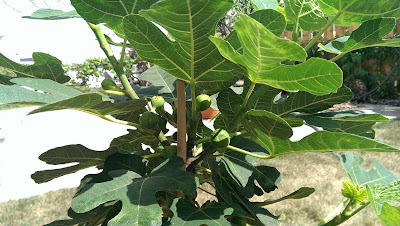Earth Etude for Elul 26 – Teshuvah and Eden
by Rabbi Robin Damsky
I am sitting in my yard as I write this, amidst the din of cicadas singing their love songs to one another, with the wind lusciously blowing around the 93-degree day. Although hot, the garden is nevertheless my favorite place. To my left are the grapevines yielding their first crop of grapes. To my right is a series of raised beds forming a giant U: lettuces under their shade cover, two compost bins, onions, carrots and beets, turnips and daikon, broccoli and collards, peppered with kale plants in every available space, with companions of sweet alyssum to keep the aphids at bay.
There is the tomato jungle; I call it thus because picking the fruits takes me into their internal forest. Only one sunflower sprouted this year, but she is majestic. Near her is the peach tree, barely able to hold up her arms right now for the weight of her pearly orangey fruits. Surrounding her are mints – chocolate and orange, spearmint and peppermint, fennel, peas and beans and onto the baby fig tree with its first set of figs: twelve. Not bad for a first year crop, and on a tree that’s just over three feet high. Aah. I exhale at the grace that God provides through these food plants.
This is only one side of the yard. Last year I began the project of turning my yard into an organic, edible landscape. Culinary herbs, fruit and nut trees, medicinal herbs, fruit shrubs, and plants with edible parts such as rose hips, ferns and violets abound. There are artichokes – Chicago’s not their normal habitat, but I’m giving them a shot. Abundant berries, winter squash, cucumbers and watermelons. And the Jewish connection: parsley, of course, hyssop and horseradish. It is a work in progress, but it is immensely fulfilling, a personal Eden.
Our tradition tells us that we were exiled from Eden to toil the soil, but I find that working the earth brings Eden. The sounds and smells, the growth and the creatures are all a piece of Eden. As a rabbi, the idea of a time when all life – human, animal and plant, can live together peaceably, is one of my main visions. The garden contains all the ingredients for that. It is a place where we learn respect, because we know the potential myriad of setbacks: weather, “pests,” soil conditions, to name a few. It is a place where we learn gratitude. How happy is the child that picks her homegrown carrot? The boy who chews on his first string bean that he planted himself?
That’s just the beginning. Sharing produce with the homeless is an important gift to give each season, through our local food pantry and homeless shelter. Bringing community members in to work the earth who need extra income helps those in need while teaching them about how to grow their own food. Simultaneously, we build community across all lines: religious, ethnic, racial, even across the generations. I have made some wonderful friends through the garden that I never would have met otherwise. And we also teach our children in the arenas of Judaism, nutrition, and sustainability.
What is teshuvah if not return? Are we not working to return to source – to God, to oneness, to wholeness with all of creation? The shofar rings out each day of Elul: Awake! Awake! Awaken to our work to create wholeness.
How interesting it is that the Messianic Age is the very vision of Eden. What better way, then, for us to do the work of the High Holy Days than to plant? We bring ourselves closer to God’s creation and advance the healing that pulls us a little closer to the Messianic Age. Plant and tend. A little Eden awaits you.
Shana tovah – A year of wholeness for all.
==========
Robin Damsky is the rabbi of West Suburban Temple Har Zion in River Forest, IL,www.wsthz.org. She is the proud mother of Sarah. In her spare time she promotes tikkun olam – repair of the world – through the garden.




Got something to say?
You must be logged in to post a comment.